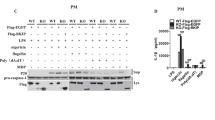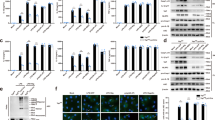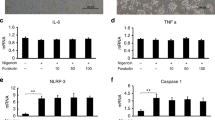Abstract
Mevalonate kinase deficiency (MKD) is a rare hereditary auto-inflammatory syndrome due to mutations in mevalonate kinase, the second enzyme of mevalonate pathway of cholesterol, and nonsterol-isoprenoids biosynthesis. The shortage of mevalonate-derived intermediates, and in particular of geranylgeranyl pyrophosphate (GGPP), has been linked with the activation of caspase-1 and thereby with the production of IL-1β, but the true concatenation of these two events has not been clarified yet. We hypothesized that inflammasomes could mediate the activation of caspase-1 due to the shortage of GGPP. We monitored the expression of the principal proteins (NALP1, NALP3 and IPAF) of the three known inflammasomes, first in a cellular model of MKD and then in two MKD patients, after bacterial lipopolysaccharide (LPS) stimulation. In healthy subjects, alendronate alone induced the expression of NALP1 and NALP3, and then together with LPS it induced a dramatic increase in NALP3 expression. In MKD patients, NALP3 expression was higher than in untreated healthy controls. Our results, although preliminary, showed that the inhibition of the mevalonate pathway led to a hyper-expression of NALP3, suggesting a possible involvement of NALP3-inflammasome in the activation of caspase-1 consequent to GGPP decrement. This is the first time that the involvement of the inflammasome complexes was shown in MKD pathogenesis.
Similar content being viewed by others
Introduction
Mevalonate kinase deficiency (MKD) is a rare autosomal recessive disease (MIM no. 610377) that is caused by mutation in MVK gene (12q24) and by the consequent reduced enzymatic activity of mevalonate kinase (MK), the second enzyme of mevalonate pathway.
MKD belongs to auto-inflammatory syndromes and it is characterized by periodic fevers variably associated with lymphoadenopathy, abdominal involvement, arhtralgia, rash, and in most severe cases, with neurological impairment.
The pathogenesis of MKD is not fully understood. Recently, it was reported that the reduced level of geranylgeranyl pyrophosphate (GGPP), a downstream mevalonate-derived intermediate, led to the activation of caspase-1 and to the secretion of the pro-inflammatory cytokine IL-1β,1, 2 explaining, almost in part, the link between the metabolic pathway impairment and the inflammatory phenotype.
The NLR (nucleotide-binding domain leucine-rich repeat containing) family of intracellular sensors is a crucial component of the innate immune system. Three members of NLR family (NALP1/NLRP1, NALP3/NLRP3 and IPAF/NLRC4) form multiprotein complexes called inammasomes, and are capable of activating the caspase-1 in response to a wide range of stimuli, including microbial and danger/stress.3 Mutations within NLRP1 and NLRP3 genes have been associated with several human diseases; sequence variants in the NLRP1 gene have been linked with auto-immune and auto-inammatory diseases associated with vitiligo,4 and mutations in NLRP3 are responsible for the auto-inammatory syndromes, Muckle–Wells syndrome, familial cold auto-inammatory syndrome and neonatal-onset multisystem inflammatory disease known collectively as cryopyrin-associated periodic syndrome (CAPS).5
In the pathogenesis of MKD, it is not clear how the reduction of geranylgeranylation leads to the activation of caspase-1; therefore, we hypothesized that this event could be mediated by the inflammasome, because of the key role of this protein complex in the inflammatory process and particularly in IL-1β secretion.3
Recently, we described a mouse model of MKD obtained through the inhibition of mevalonate pathway with alendronate combined with the induction of acute inflammation with a bacterial compound.6 Similarly, we treated human monocytes with alendronate and bacterial lipopolysaccharide (LPS) to simulate a cellular model for a MKD typical episode.
As NALP1/NLRP1, NALP3/NLRP3 and IPAF/NLRC4 are the principal and characteristic molecules of the respective inflammasomes, we first monitored their expression in our experimental cellular model of MKD pathology and then in two MKD patients to verify their role as specific markers for the involvement of each inflammasome.
Materials and methods
Cells isolation and culture
After approval by the ethics review board of the IRCCS ‘Burlo Garofolo’ and after written informed consent, blood was drawn from eight healthy volunteers and two patients with MKD. Human peripheral blood mononuclear cells (HPBMCs) were isolated by density gradient centrifugation using Ficoll-Paque (GE Healthcare, Uppsala, Sweden) and cultured in RPMI-1640 (Euroclone, Italy) containing 2 mM glutamine, 100 U/ml penicillin–streptomycin and 10% fetal calf serum (FCS, Euroclone, Milano, Italy). 2 × 106 HPBMCs from healthy donors or MKD patients were incubated with or – in the case of patients – without alendronate 100 μ M for 24 h and with LPS 1 μg/ml for 4 h. Alendronate (Sigma Aldrich) and LPS (Sigma Aldrich, Milano, Italy) were dissolved in distilled water (respectively at 10 mM and 1 mg/ml).
Patients
In all, two patients affected by MKD were enrolled in this study (P1 male, 12 years old; and P2 female, 20 years old). They both showed characteristic clinical features of the disease, such as fever (3–5 days) every 2–3 weeks, always accompanied by lymphoadenopathy, skin rash, abdominal pain and arthralgy. Laboratory exams showed increased inflammatory markers (CRP and ESR) and leukocytosis during fever episodes. Compound heterozygosity for common mutations in MVK gene were identified in both patients. P1 carries the V377I (c.1129G>A) and the I268T (c.803T>C) substitution; and P2 the V377I and the deletion c.16-34 del.
IL-1β measurement
IL-1β measurement was performed using the Endogen IL-1β ELISA kit (Pierce Biotechnology Inc., USA). Results were expressed as pg/ml.
RNA isolation and expression analysis
Total RNA was extracted using the Purescript kit (Gentra Systems, Minneapolis, MN, USA) and retro-transcribed with the GeneAmp RNA PCR kit (Applied Biosystems, Forster City, CA, USA). NLRP1, NLRP3, NLRC4 and CASP1 were amplified with specific TaqMan Gene Expression Assays (Hs00248187_m1, Hs00366465_m1, Hs00368367_m1 and Hs00354838_m1) using the ABI 7900 HT SDS platform (Applied Biosystems). HPRT1 was the housekeeping gene (4333768F; Applied Biosystems) used for normalization. Relative quantitative expression was calculated as 2−DDCT following the indications of Livak et al.7
Results
HPBMCs were cultured for 24 h in the presence or absence of alendronate and stimulated for an additional 4 h with LPS. The inhibition of mevalonate pathway with alendronate is able to induce in monocytes the secretion of IL-1β in the presence of a second stimulus (Figure 1) as previously reported for RAW 264 murine macrophage cells and J774.1 cells.8, 9
ALD and ALD/LPS treatment alter inflammasome genes expression in HPBMCs. HPBMCs from healthy blood donors were treated with alendronate (ALD), bacterial lipopolysaccharide (LPS) or ALD/LPS. Expression of NLRP1/NALP1, NLRP3/NALP3, NLRC4/IPAF and CASP1/ICE1 was measured using real-time quantitative PCR, and results were normalized to HPRT1 expression. Expression of untreated cells was normalized to 1 (not reported in the graph). Expression data for the eight experiments are reported as 2−DDCt average±SD, in which DDCt=DCt_stimulatedHC–DCt_RHC. The small panel above shows average±SD (for the eight experiments performed) of IL-1β secretion. Results of t-test were expressed with *P<0.05; **P<0.01.
Expression data obtained in ALD-, LPS- and ALD/LPS-treated HPBMCs were compared with those acquired using untreated cells (R) (Supplementary Table A1), and the results obtained in a representative experiment are reported in Figure 1.
In healthy subjects alendronate induced an approximately twofold increase in the expression of NLRP1 and NLRP3. LPS induced a fourfold increase in NLRP3 expression. ALD/LPS induced a major increase in NLRP3 expression (10.55-fold). NRLC4 was not detectable in HPBMCs. The ALD/LPS induction of NLRP3 was always accompanied by the induction of CASP1 and by the relevant secretion of IL-1β (Figure 1).
When HPBMCs isolated from healthy controls were compared with HPBM from MKD subjects, we found an increase in the basal expression of NLRP3 in patients with the disease. In particular, as showed for patient P1 in Figure 2a (Supplementary Table A2), NLRP3 was 3.41-fold more expressed in the untreated patient when compared with untreated healthy control.
Inflammasome genes expression in MKD patients. Expression of NLRP1/NALP1, NLRP3/NALP3, NLRC4/IPAF and CASP1/ICE1 in one subject affected by MKD was measured using real-time quantitative PCR, and results were normalized to HPRT1 expression. (a) Basal (resting, R) mRNA level of NLRP1, NLRP3, NLRC4 and CASP1 were compared in HPBMCs isolated from the MKD patient and from one healthy donor and reported as 2−DDCt in which DDCt=DCt_RMKD – DCt_RHC. (b) HPBMCs from the MKD patient were treated with LPS and the mRNA levels of NLRP1, NLRP3, NLRC4 and CASP1 were evaluated by comparing patient expression, after LPS induction, with patient expression in basal and untreated condition (R). Expression results are reported as 2−DDCt in which DDCt=DCt_LPSMKD–DCt_RMKD. Expression of untreated cells is normalized to 1 (not reported in the graph). The LPS-induced secretion of IL-1β relative to the same experiment is reported on the right of the graph. Data are referring to one of the two patients studied.
MKD HPBMCs stimulated with LPS showed increased levels of NLRP1 and NLRC4 mRNA when compared with untreated ones (R), whereas NLRP3 expression was the same in R and LPS-treated cells. In patient P1, NLRP1 and NLRC4 were induced by LPS treatment, showing expression values of 2.80-fold and 2.65-fold with respect to the untreated cells (Figure 2b and Supplementary Table A3). A similar expression pattern was also observed in the other patient even when the induction rates varied (NLRP1=0.82-fold; NLRP3=1.27-fold; NLRC4=0.74-fold; and CASP1=1.95-fold).
Discussion
MKD is an auto-inflammatory syndrome caused by a genetic defect in mevalonate pathway and isoprenoid biosynthesis. Recent studies have established that patients have hyperactive caspase-1 due to a shortage of geranylgeranylated proteins and an increased IL-1β secretion.1, 2 When PAMPs or DAMPs (ie, vaccine, microbial infection, stress and fatigue) stimulate innate immune system of MKD patients, it results in typical inflammatory attacks.
In this study, we considered the hypothesis that the activation of caspase-1 – due to the inhibition of mevalonate pathway – could be mediated by one of the three known inflammasomes. Indeed, the principal role showed for NALP1-, NALP3- and IPAF-inflammasome is the cleavage of pro-caspase-1 in its active form.
Because of the limited number of patients, we used a cellular model based on the treatment of human monocytes with the aminobisphosphonate alendronate (inhibitor of mevalonate pathway) and a bacterial compound, to substantiate the inflammasome involvement in the pathogenesis of MKD, through the study of the NALP1/NLRP1, NALP3/NLRP3 and IPAF/NLRC4 expression.
In this model, we have shown that alendronate alone, and even more together with LPS, induces a great IL-1β secretion and also upregulates the transcription of CASP1 and of the three inflammasome' genes. In particular, NALP3/NLRP3 seems to be the most susceptible to inhibition of the mevalonate pathway. In physiologic condition NLRP3 expression could be induced by common pro-inflammatory compounds, such as LPS, TNF and IL-1β;10 this is the first time to our knowledge that the induction of NLRP3 through a metabolic impairment was reported.
When the same experiments were conducted in monocytes isolated from the only two MKD patients available at the moment of the study, we observed that NALP3/NLRP3 is already hyper-expressed in untreated cells and probably it was the reason why it could not be further inducible by LPS. This result suggests that MKD patients are characterized by basal high levels of NLRP3, independently of any kind of stimulation. The association between the genetic defect in mevalonate pathway and NLRP3 transcription needs to be replicated in a greater number of MKD patients.
Different to what was expected on the basis of the results obtained in our cellular model, the induction of NLRP1 and NLRC4 by LPS treatment was observed only in patients and not in the control samples, leading us to hypothesize that being NLRP3 transcription dysregulated, other inflammasomes (ie, NLRP1 and NLRC4) can have a role in the regulation of inflammation.
Of course, we cannot exclude that a more general consequence of the mevalonate pathway metabolic block involves other genes besides NLRP3 and inflammasome. How the metabolic dysregulation could affect the gene transcription is currently under investigation and we cannot exclude that an epigenetic effect occurs.
Further investigations are needed to confirm the involvement of NALP3-inflammasome deregulation in the pathogenesis of MKD. In chronic inflammatory disorders, such as rheumatoid arthritis, NLRP3 has been reported to be upregulated,11 but no role for NALP3-inflammasome has been shown so far in the pathogenesis of this disease. Considering that the constitutive activation of NALP3-inflammasome is associated with several auto-inflammatory syndromes, such as familial cold urticaria, Muckle–Wells syndrome, CINCA syndrome and familial Mediterranean fever, it was conceivable that, at least indirectly, its deregulation could also be involved in the pathogenesis of MKD. Furthermore, the constitutive activation of NALP3 inflammasome leads to decreased apoptosis,12 an event that was also observed in leukocytes from MKD subjects.13
It could be interesting to monitor NLRP3 expression in our previously reported animal model of MKD after treatment with alendronate.6 Moreover, the role of NALP3-inflammasome in the inflammation induced by the mevalonate pathway inhibition could be substantiated in mice KO for NLRP3 or other inflammasome genes.
A proteomic approach is difficult nowadays because of the lack of easy technical methods to discriminate the active form of NALP3 from its inactive one. All the research in this field has been made using recombinant mutated proteins.14
The results reported in this study, although preliminary, support our hypothesis about the involvement of inflammasomes, in particular NALP3-inflammasome, in the activation of caspase-1 within the pathogenetic events that, starting from the impairment of mevalonate-derived intermediates, lead to the inflammatory systemic effects observed in MKD.
References
Mandey SH, Kuijk LM, Frenkel J, Waterham HR : A role for geranylgeranylation in interleukin-1beta secretion. Arthritis Rheum 2006; 54: 3690–3695.
Kuijk LM, Mandey SH, Schellens I et al: Statin synergizes with LPS to induce IL-1β release by THP-1 cells through activation of caspase-1. Mol Immunol 2008; 45: 2158–2165.
Martinon F, Mayor A, Tschopp J : The inflammasomes: guardians of the body. Annu Rev Immunol 2009; 27: 229–265.
Jin Y, Mailloux CM, Gowan K et al: NALP1 in vitiligo-associated multiple autoimmune disease. N Engl J Med 2007; 356: 1216–1225.
Neven B, Prieur AM, Quartier dit Maire P : Cryopyrinopathies: update on pathogenesis and treatment. Nat Clin Pract Rheumatol 2008; 4: 481–489.
Marcuzzi A, Pontillo A, De Leo L et al: Natural isoprenoids are able to reduce inflammation in a mouse model of mevalonate kinase deficiency. Pediatr Res 2008; 64: 177–182.
Livak KJ, Schmittgen TD : Analysis of relative gene expression data using real-time quantitative PCR and the 2–ΔΔCT method. Methods 2001; 25: 402–408.
Töyräs A, Ollikainen J, Taskinen M, Mönkkönen J : Inhibition of mevalonate pathway is involved in alendronate-induced cell growth inhibition, but not in cytokine secretion from macrophages in vitro. Eur J Pharm Sci 2003; 19: 223–230.
Deng X, Tamai R, Endo Y, Kiyoura Y : Alendronate augments interleukin-1beta release from macrophages infected with periodontal pathogenic bacteria through activation of caspase-1. Toxicol Appl Pharmacol 2009; 235: 97–104.
O'Connor Jr W, Harton JA, Zhu X, Linhoff MW, Ting JP : CIAS1/cryopyrin/PYPAF1/NALP3/CATERPILLER 1.1 is an inducible inflammatory mediator with NF-kappa B suppressive properties. J Immunol 2003; 171: 6329–6333.
Rosengren S, Hoffman HM, Bugbee W, Boyle DL : Expression and regulation of cryopyrin and related proteins in rheumatoid arthritis synovium. Ann Rheum Dis 2005; 64: 708–714.
Feldmann J, Prieur AM, Quartier P et al: Chronic infantile neurological cutaneous and articular syndrome is caused by mutations in CIAS1, a gene highly expressed in polymorphonuclear cells and chondrocytes. Am J Hum Genet 2002; 71: 198–203.
Bodar EJ, van der Hilst JC, van Heerde W, van der Meer JW, Drenth JP, Simon A : Defective apoptosis of peripheral-blood lymphocytes in hyper-IgD and periodic fever syndrome. Blood 2007; 109: 2416–2418.
Fujisawa A, Kambe N, Saito M et al: Disease-associated mutations in CIAS1 induce cathepsin B-dependent rapid cell death of human THP-1 monocytic cells. Blood 2007; 109: 2903–2911.
Acknowledgements
We acknowledge the participation of the patients, control subjects and family members. This work was funded by the Institute for Maternal and Child Health, IRCCS ‘Burlo Garofolo’, Trieste, Italy (RC 13/08).
Author information
Authors and Affiliations
Corresponding author
Ethics declarations
Competing interests
The authors declare no conflict of interest.
Additional information
Supplementary Information accompanies the paper on European Journal of Human Genetics website
Supplementary information
Rights and permissions
About this article
Cite this article
Pontillo, A., Paoluzzi, E. & Crovella, S. The inhibition of mevalonate pathway induces upregulation of NALP3 expression: new insight in the pathogenesis of mevalonate kinase deficiency. Eur J Hum Genet 18, 844–847 (2010). https://doi.org/10.1038/ejhg.2010.9
Received:
Revised:
Accepted:
Published:
Issue Date:
DOI: https://doi.org/10.1038/ejhg.2010.9
Keywords
This article is cited by
-
Autoinflammatory Keratinization Diseases—The Concept, Pathophysiology, and Clinical Implications
Clinical Reviews in Allergy & Immunology (2023)
-
Alendronate Augments Lipid A–Induced IL-1α Release via Activation of ASC but Not Caspase-11
Inflammation (2021)
-
Autoinflammatory Syndromes in Children
The Indian Journal of Pediatrics (2016)
-
Perception of self: distinguishing autoimmunity from autoinflammation
Nature Reviews Rheumatology (2015)
-
Hyper-IgD syndrome/mevalonate kinase deficiency: what is new?
Seminars in Immunopathology (2015)





